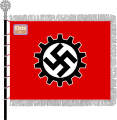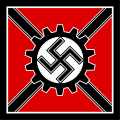Flags of the German Labor Front
The flags of the German Labor Front (1933-1945) were the flags and pennants of the Union of Employees and Employers (DAF) used during the Nazi era .
Flags, factory and podium flags
From 1934, the DAF operating units with over 200 members were assigned their own official flags. These consisted of a 140 cm long and 120 cm high, red cloth. In the center of the flag was the symbol of the DAF on a white circular disk, a black gear with 14 teeth, inside of which was a black swastika . These first flags had no fringes on the edge and the top of the flagpole had a simple swastika. Originally, the symbolic gear wheel of the DAF was supposed to have 17 teeth, so that there is a possibility that flags with such gear wheels were made from time to time in the early years. Modifications made in the course of 1934 finally led to a final version at the beginning of 1935 in which the white circular disc was omitted and the gearwheel was ultimately only given a narrow, white border. From 1937, silver fringes were added to the flags. The number of fastening rings on the flagpole, the tip of which now also showed a gear, was fixed at eight.
Depending on the affiliation of the unit, flag mirrors were attached to the top left corner of the cloth: For district administrations there was a red-brown mirror with a black border, while local administrations received a light brown mirror with a light blue border. The name of the administration was applied in white Gothic letters. Businesses or factories led the mirror of the local administration with the additional number of the business in white, Arabic numerals.
In order to increase the work performance of the factories for Hitler's war aims, the honorary title of a National Socialist model factory was introduced on September 1, 1936 . This title was given to companies that were best able to implement the propagated Nazi community . In addition to other awards, such model companies were granted the right to use a special model company flag ("Golden DAF flag") on May 1st of each year . This was a traveling flag, as the title was only awarded for one year. For this reason such flags did not have a flag mirror. The sample company flags were similar to the usual flags, but showed a gold-colored, black-framed gear wheel. The swastika was also bordered in black and white. The tip of the flag and the fringes were gold.
After the beginning of the war in September 1939, the performance struggle of the companies and thus the awarding of the flags was stopped, in order to revive in a new form from 1941 as a war performance struggle of the German companies . As a result, new flags were given to the so-called war model companies. These corresponded in particular to the previous versions with the special feature of the reproduction of the War Merit Cross 1st Class (without swords) at the flying end of the flag. In addition, a so-called war flag of honor was introduced for companies that were not model companies, but which fulfilled the services for objectives important to the war effort. This flag corresponded to the normal carrying flag of the DAF, but with the swastika of the model companies and the War Merit Cross.
1 = Carrying flag of the DAF (here local group "Rheine", company no. 6), version from 1937
2 = Carrying flag of the DAF (here district administration "Aalen"), version from 1937
3 = DAF model company flag (golden flag of the DAF)
4 = War Honor flag with War Merit Cross 1st Class without swords
5 = War model company flag with War Merit Cross 1st Class without swords
In order to show the public for propaganda purposes which companies had been awarded special honorary titles, all flags were also produced as factory flags and placed visibly in front of or on the buildings. Fringes were replaced by simple borders. The flagpoles were simply designed. In the case of the war model company flag , the gear and swastika were offset to the left.
During speeches by DAF officials, grandstands or podiums were covered with flags showing the symbol of the German Labor Front. These were of different sizes and not designed uniformly.
1 = general flag of the DAF
2 = model company flag
3 = war honor flag
4 = war model company flag
5 = grandstand and podium flag (example)
Vehicle flags
Higher functionaries or leaders of the German Labor Front were allowed to equip their vehicles with special stands. For this purpose, flags were set by an order from the Reichszeugmeisterei in 1934. For the head of the DAF, Robert Ley , a service stand measuring 30 × 30 cm was specified, which was attached to the left fender of the vehicle. On the right fender he also led the stand of a Reich Leader .
Gauobmanns and heads of the offices in the central office kept a pennant measuring 25 × 37 cm. This pennant was also allowed to be affixed to the vehicle by heads of Reich operating associations.
For other DAF managers, a simple red pennant with the DAF symbol was used, which in one variant had an additional white field at the top. If necessary, this could probably be given a more detailed standard designation.
1 = Service stand of the head of the DAF
2 = Service stand (pennant) for district officers and heads of the offices in the central office
3 = DAF vehicle pennant
4 = DAF vehicle pennant with identification field
Flags and pennants of the Nazi community Strength through Joy
The Community Kraft durch Freude (Strength through Joy) was a sub-organization of the German Labor Front, which had the task of the leisure of population equal to switch . As such, it was probably equipped with various flags as early as 1933. The symbol of the KdF organization was the gear and swastika surrounded by a stylized sun wheel that was depicted on a flag with a red cloth. Different variants of this flag existed. B. the symbol was shown inside a white circular disk. The swastika was also made either black or red. On the KdF ships, the sun wheel symbol was depicted on a white cloth, while flags that were shown at sporting events had a red border. All KdF ships carried a white KdF pennant in the top of the main mast, which had the inscription “Kraft durch Freude” in red, mostly Gothic letters.
1 = KdF flag
2 = KdF ship flag
3 = KdF sport flag
4 = KdF ship pennant
literature
- Der Flaggenkurier Nr. 30, Berlin 2009, Journal of the German Society for Flag Studies, ISSN 0949-6173
- Davis / McGregor: Flags of the Third Reich , Part 3, London 1994, ISBN 1 85532 459 8
- Andreas Herzfeld: The Rimann Collection of German Car Flags and Vehicle Stands , Volume 1, Berlin 2013, ISBN 978-3-935131-08-7
Individual evidence
- ↑ MBl RZM 1934, edition 1, p. 3


















